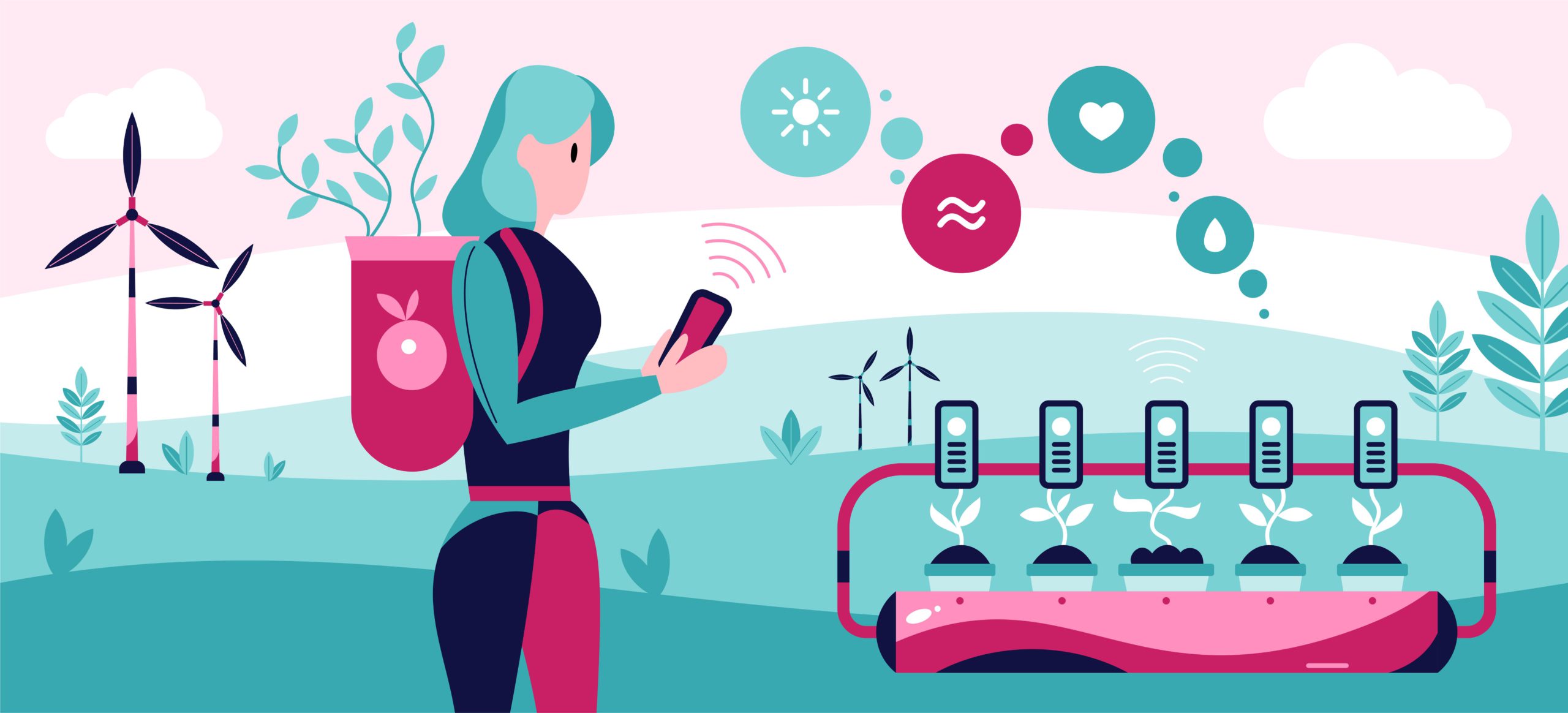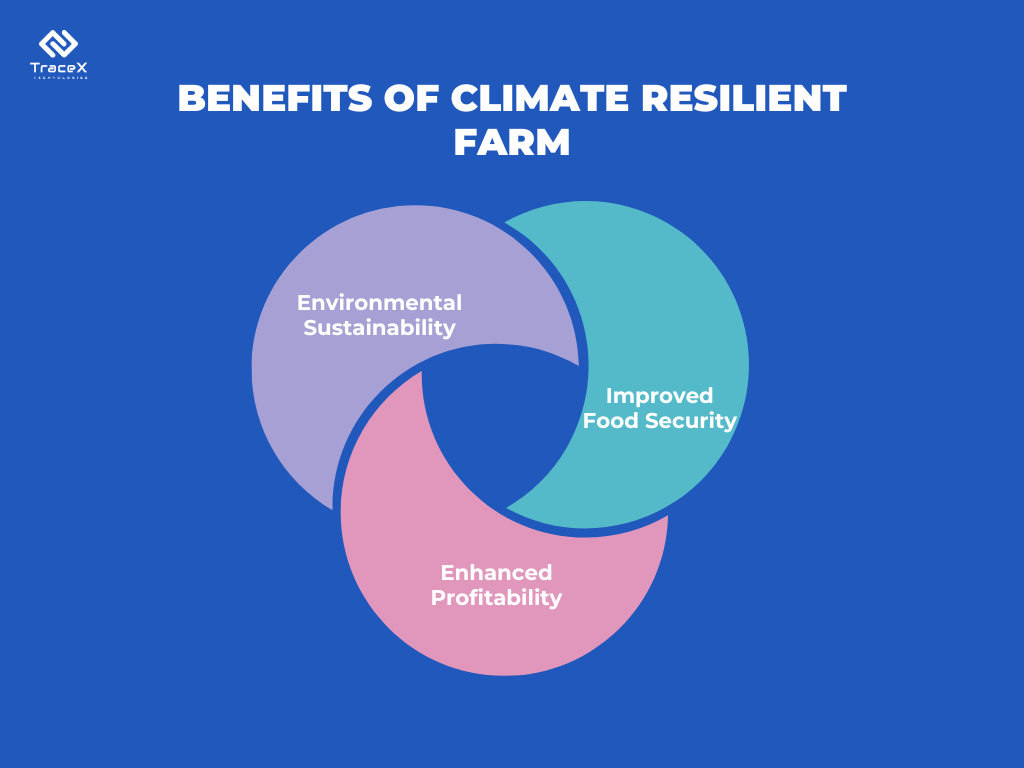Contact: +91 99725 24322 |
Menu
Menu
Quick summary: Discover how innovative technologies and sustainable practices are transforming agriculture to build climate resilience. Explore strategies to empower farmers, ensure food security, and create a sustainable future for generations to come.

Do you know, building climate resilience in agriculture isn’t just about survival—it’s about empowering farmers to thrive in the face of uncertainty, ensuring they can continue to nourish the world for generations to come. For the millions of farmers who rely on stable climates to feed their families and communities, the stakes couldn’t be higher.
In recent years, the agriculture sector has increasingly found itself at the crossroads of climate change and global food security. As climate change accelerates, its impact on agriculture becomes more apparent and more severe. Rising temperatures, unpredictable weather patterns, and extreme events are threatening crop yields, livestock productivity, and the livelihoods of millions of farmers worldwide.
Agriculture is both a victim and a contributor to climate change, making it a focal point in the fight for a sustainable future.
Climate resilience in agriculture refers to the ability of farming systems to withstand, recover from, and adapt to climate-related stresses and shocks. This includes developing strategies to cope with droughts, floods, heatwaves, and other extreme weather events, as well as long-term changes in temperature and precipitation patterns. Building climate resilience requires a multi-faceted approach that addresses various aspects of agricultural production, from crop selection and soil management to water use and post-harvest handling. By adopting a range of resilience-enhancing practices, farmers can reduce their vulnerability to climate risks and ensure the long-term viability of their operations.
The challenges posed by climate change are multifaceted and interconnected. Rising global temperatures, for instance, are not just a cause of heat stress in crops and livestock; they also lead to water scarcity, soil degradation, and the proliferation of pests and diseases. Unpredictable rainfall patterns disrupt planting and harvesting cycles, while extreme weather events—such as floods, hurricanes, and droughts—can wipe out entire harvests in a matter of hours.
These challenges are exacerbated by the socioeconomic vulnerabilities of farmers, particularly in developing countries. Smallholder farmers, who produce a significant portion of the world’s food, are often the least equipped to cope with climate variability. Limited access to resources, technology, and information puts them at greater risk, making climate resilience a matter of survival for millions of families.
Agriculture is a significant contributor to climate change, accounting for about 10-12% of global greenhouse gas (GHG) emissions. This includes emissions from livestock production, rice cultivation, fertilizer application, and land-use changes such as deforestation. The irony is that while agriculture contributes to climate change, it is also one of the most vulnerable sectors to its impacts.
The release of methane from cattle, nitrous oxide from fertilizers, and carbon dioxide from deforestation are some of the main ways agriculture drives climate change. These emissions contribute to the greenhouse effect, trapping heat in the earth’s atmosphere and leading to global warming.
The impact of climate change on agriculture is profound and far-reaching. In many regions, changing precipitation patterns are leading to more frequent and severe droughts, reducing water availability for irrigation and threatening crop yields. On the other hand, excessive rainfall and flooding can destroy crops, erode soil, and create breeding grounds for pests and diseases.
Temperature increases are also altering growing seasons, with some crops no longer viable in regions where they have traditionally been grown. Heat stress affects not only crops but also livestock, reducing their productivity and increasing mortality rates. The changing climate is also expanding the range of pests and diseases, further complicating pest management and increasing the need for chemical inputs, which can have negative environmental and health impacts.
To build climate resilience, the adoption of sustainable agriculture practices is essential. These practices include conservation tillage, crop diversification, agroforestry, and integrated pest management. By maintaining soil health, conserving water, and reducing reliance on chemical inputs, these practices help create farming systems that are more resilient to climate variability.
For instance, conservation tillage, which involves minimal disturbance of the soil, helps preserve soil moisture, reduce erosion, and enhance soil fertility. Crop diversification—growing a variety of crops—reduces the risk of total crop failure due to climate shocks. Agroforestry, which integrates trees and shrubs into farming systems, provides multiple benefits, including carbon sequestration, improved biodiversity, and enhanced resilience to extreme weather events.
Water is a critical resource for agriculture, and its availability is increasingly threatened by climate change. Efficient water management practices, such as drip irrigation, rainwater harvesting, and the use of drought-resistant crop varieties, are essential for building climate resilience and conserving water.
Drip irrigation, for example, delivers water directly to the roots of plants, reducing water wastage and improving water-use efficiency. Rainwater harvesting systems capture and store rainwater for use during dry periods, ensuring a reliable water supply even in times of scarcity. Additionally, the development and adoption of drought-resistant crop varieties can help ensure food production even under challenging climatic conditions.
Climate-smart agriculture (CSA) is an approach that integrates the three dimensions of sustainable development (economic, social, and environmental) by jointly addressing food security and climate change. CSA involves practices and technologies that help farmers adapt to climate change, reduce GHG emissions, and enhance agricultural productivity.
Key CSA practices include improved crop varieties, precision agriculture, and sustainable land management. Precision agriculture, which uses technology to optimize field-level management regarding crop farming, helps farmers apply inputs like water, fertilizers, and pesticides more efficiently, reducing waste and minimizing environmental impact.
Building resilience in agriculture also requires addressing the social and economic vulnerabilities of farming communities. This includes providing access to climate information services, financial resources, and training programs that equip farmers with the knowledge and tools they need to adapt to changing conditions.
For example, weather forecasting services can provide farmers with timely information on expected weather patterns, allowing them to make informed decisions about planting, irrigation, and harvesting. Access to credit and insurance can help farmers invest in climate-resilient technologies and recover from climate-induced losses. Training programs that promote sustainable agriculture practices can empower farmers to adopt new techniques and improve their resilience to climate change.
AFOLU stands for Agriculture, Forestry, and Other Land Use, a sector that plays a critical role in the global carbon cycle. AFOLU activities include all human activities related to the use of land, whether for agriculture, forestry, or other purposes. These activities are significant because they both emit and sequester GHGs, making AFOLU a key area for climate change mitigation.
The AFOLU sector is responsible for about 24% of global GHG emissions, primarily from deforestation, land degradation, and agricultural practices.
However, it also has the potential to sequester large amounts of carbon through practices like reforestation, afforestation, and sustainable land management.
To mitigate climate change, AFOLU strategies focus on reducing emissions from land-use activities and enhancing carbon sequestration. These strategies include:
1. Reducing Deforestation and Forest Degradation: Protecting existing forests and restoring degraded ones is one of the most effective ways to reduce GHG emissions. Forests act as carbon sinks, absorbing carbon dioxide from the atmosphere and storing it in biomass and soil.
2. Sustainable Land Management: Practices like agroforestry, improved pasture management, and soil conservation help maintain or enhance the carbon content of soils, reducing emissions and increasing carbon sequestration.
3. Improving Agricultural Productivity: Increasing the efficiency of agricultural production can reduce the need to convert additional land for agriculture, thereby reducing deforestation and associated emissions. This can be achieved through the adoption of high-yield crop varieties, improved irrigation techniques, and better nutrient management.
4. Reforestation and Afforestation: Planting trees on degraded lands (reforestation) or on lands not previously forested (afforestation) can sequester significant amounts of carbon, contributing to climate change mitigation. These activities also provide additional benefits, such as biodiversity conservation, soil protection, and enhanced water regulation.
5. Livestock Management: Livestock production is a major source of methane emissions, a potent GHG. Improved livestock management practices, such as better feed quality, rotational grazing, and manure management, can reduce emissions and improve the efficiency of livestock production.

Agritech, the fusion of agriculture and technology, plays a pivotal role in building climate resilience within the agricultural sector. As climate change continues to disrupt traditional farming practices, agritech offers innovative solutions that enable farmers to adapt, mitigate risks, and sustain productivity.
One of the most significant contributions of agritech to climate resilience is precision agriculture. Using GPS, IoT sensors, and data analytics, precision agriculture allows farmers to monitor and manage crops with unprecedented accuracy. By optimizing water usage, nutrient application, and pest control, farmers can reduce waste, conserve resources, and minimize environmental impact. This not only helps in adapting to changing climatic conditions but also ensures sustainable agricultural practices.
Agritech enables the adoption of climate-smart farming practices by providing tools and technologies that help farmers adapt to extreme weather conditions. For example, satellite imagery and weather forecasting models allow farmers to anticipate and prepare for droughts, floods, or heatwaves. These insights enable timely decision-making, such as adjusting planting schedules, selecting drought-resistant crop varieties, or implementing water-saving irrigation techniques.
Digital platforms powered by blockchain and AI are transforming how farmers access and manage information. These platforms offer real-time data on soil health, weather patterns, and market trends, helping farmers make informed decisions that enhance their resilience. Moreover, blockchain technology ensures transparency and traceability in the supply chain, which is crucial for maintaining trust and ensuring compliance with sustainability standards.
Agritech plays a critical role in sustainable resource management by providing tools that optimize the use of water, energy, and inputs like fertilizers and pesticides. For instance, smart irrigation systems can reduce water consumption by delivering precise amounts of water based on real-time soil moisture data. Similarly, energy-efficient machinery and renewable energy solutions, such as solar-powered equipment, help reduce the carbon footprint of farming activities.
Agritech is also helping farmers manage financial risks associated with climate change. Digital finance platforms offer microloans, insurance products, and payment solutions tailored to the needs of smallholder farmers. For example, weather-indexed insurance products provide payouts based on weather conditions rather than crop loss, offering a safety net in case of climate-induced disasters. These financial tools empower farmers to invest in resilience-building practices without fear of financial ruin.
Smallholder farmers, who are often the most vulnerable to climate change, benefit immensely from agritech solutions. Mobile applications provide them with access to critical information on climate adaptation strategies, market prices, and best practices. These tools bridge the knowledge gap, enabling smallholders to adopt innovative practices that enhance their resilience and improve their livelihoods.
Explore how our partnership with a leading climate consultancy transformed natural farming practices into actionable insights.
TraceX’s Sustainability Platform offers a robust tech-driven solution to enhance climate resilience in agriculture. The platform leverages IoT sensors, blockchain technology, and analytics to provide real-time traceability and data-driven insights across the entire farming lifecycle. By integrating Digital MRV capabilities, TraceX ensures precise measurement, reporting, and verification of sustainability practices, enabling farmers to track carbon credits and meet regulatory standards. The platform’s climate-smart agriculture tools empower farmers to adopt adaptive strategies like efficient water management, crop diversification, and conservation tillage. Additionally, TraceX fosters supply chain transparency through blockchain, ensuring that all stakeholders—from farmers to consumers—are aligned in promoting sustainable and climate-resilient practices. This tech-driven approach not only enhances operational efficiency but also ensures that agriculture can withstand and adapt to the challenges posed by climate change.
Building climate resilience in agriculture is not just a necessity—it’s a responsibility we owe to future generations. By embracing innovative technologies and sustainable practices, we can empower farmers to adapt and thrive, ensuring that our global food systems remain robust and secure. But this journey requires more than just technological solutions; it calls for collaboration, education, and a shared commitment to nurturing our planet. Together, we can create a resilient agricultural future where both people and the environment flourish, leaving a legacy of sustainability and hope.
